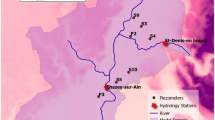Abstract
In this study, a simulation–optimization approach for optimal determination of groundwater withdrawal wells location and pumping rate is developed while incorporating quantitative and water-quality objectives into the objective function simultaneously. The proposed model integrates the groundwater flow simulation model MODFLOW and particle-swarm optimization (PSO) algorithm and is applied to Sarakhs aquifer in Iran as the case study to minimize the total cost of drilling, transfer, and water treatment. Discharges and the location of pumping wells are taken as the decision variables. In addition, the maximum pumping rate and maximum allowable water-table drawdown while meeting the required quality for domestic water are incorporated as the constraints. Results show that the proposed approach not only satisfies the constraints, but also reduces the cost of water withdrawal comparing the existing plan. Sensitivity analysis indicates that results are not significantly sensitive to variation in aquifer’s hydraulic conductivity, while the maximum pumping rate directly affects the number of required wells and can, therefore, make a considerable change in the final cost.









Similar content being viewed by others
References
Ahlfeld DP, Barlow PM, Mulligan AE (2005) GWM—a ground-water management process for the US geological survey modular ground-water model (MODFLOW 2000). US Geol Surv Open File Rep 1072:124
Ayvaz MT, Elçi A (2013) A groundwater management tool for solving the pumping cost minimization problem for the Tahtali watershed (Izmir-Turkey) using hybrid HS-solver optimization algorithm. J Hydrol 478:63–76
Ch S, Kumar D, Prasad RK, Mathur S (2013) Optimal design of an in situ bioremediation system using support vector machine and particle swarm optimization. J Contam Hydrol 151:105–116
Chaudhry S (2003) Unit cost of desalination. California desalination task force, California Energy Commission, Sacramento, California
Chiu YC, Nishikawa T, Martin P (2012) Hybrid-optimization algorithm for the management of a conjunctive-use project and well field design. Groundwater 50(1):103–117
Conkling H (1946) Utilization of ground-water storage in stream system development. Trans Am Soc Civil Eng 111(1):275–305
Elçi A, Ayvaz MT (2014) Differential-evolution algorithm based optimization for the site selection of groundwater production wells with the consideration of the vulnerability concept. J Hydrol 511:736–749
Gaur S, Chahar BR, Graillot D (2011) Analytic elements method and particle swarm optimization based simulation-optimization model for groundwater management. J Hydrol 402(3–4):217–227
Ghaseminejad A, Shourian M (2016) Optimal design of groundwater wells’ placement and pumping rates by use of a simulation-optimization approach. Iran Water Resour Res 12(2):24–37 (In Persian)
Harbaugh AW (2005) MODFLOW-2005, the US geological survey modular ground-water model: the ground-water flow process. US Department of the Interior, US Geological Survey, Reston, pp 6–A16
Hsiao C-T, Chang L-C (2002) Dynamic optimal groundwater management with inclusion of fixed costs. J Water Resour Plan Manage 128(1):57–65
Huang C, Mayer AS (1997) Pump-and-treat optimization using well locations and pumping rates as decision variables. Water Resour Res 33(5):1001–1012
Katsifarakis KL, Petala Z (2006) Combining genetic algorithms and boundary elements to optimize coastal aquifers’ management. J Hydrol 327(1–2):200–207
Kennedy J, Eberhart R (1995) Particle swarm optimization. In: Proceedings of the IEEE international joint conference on neural networks, pp 1942–1948
Mantoglou A, Papantoniou M, Giannoulopoulos P (2004) Management of coastal aquifers based on nonlinear optimization and evolutionary algorithms. J Hydrol 297(1–4):209–228
McKinney DC, Lin M-D (1994) Genetic algorithm solution of groundwater management models. Water Resour Res 30(6):1897
Park CH, Aral MM (2004) Multi-objective optimization of pumping rates and well placement in coastal aquifers. J Hydrol 290(1–2):80–99
Parsopoulos KE, Vrahatis MN (2002) Recent approaches to global optimization problems through particle swarm optimization. Nat Comput 1:235–306
Shourian M, Davoudi SMJ (2017) Optimum pumping well placement and capacity design for a groundwater lowering system in urban areas with the minimum cost objective. Water Resour Manage 31(13):4207–4225
Singh A (2014) Simulation and optimization modeling for the management of groundwater resources. II: combined applications. J Irrig Drain Eng 140(4):04014002
Tapoglou E, Trichakis IC, Dokou Z, Nikolos IK, Karatzas GP (2014) Groundwater-level forecasting under climate change scenarios using an artificial neural network trained with particle swarm optimization. Hydrol Sci J 59(6):1225–1239
Todd DK, Mays LW (2005) Groundwater hydrology edition. Wiley, New York
Yeh WW (2015) Optimization methods for groundwater modeling and management. Hydrogeol J 23(6):1051–1065
Author information
Authors and Affiliations
Corresponding author
Additional information
Publisher's Note
Springer Nature remains neutral with regard to jurisdictional claims in published maps and institutional affiliations.
Rights and permissions
About this article
Cite this article
Ghaseminejad, A., Shourian, M. A simulation–optimization approach for optimal design of groundwater withdrawal wells’ location and pumping rate considering desalination constraints. Environ Earth Sci 78, 270 (2019). https://doi.org/10.1007/s12665-019-8273-5
Received:
Accepted:
Published:
DOI: https://doi.org/10.1007/s12665-019-8273-5




